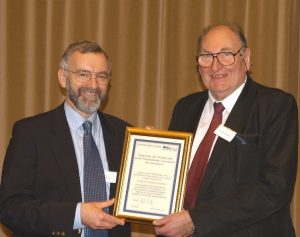
In the tough world of industrial analysis in the mid-1960s, Stan – as he was universally known – and his colleagues in the analytical group of Albright & Wilson Limited, a UK manufacturing company specializing in phosphorous-based chemicals, were grappling with the problem of interference from phosphorous and aluminium on the determination of calcium by flame photometry. They knew that these effects could be reduced if the flame temperature was increased. Higher temperature oxy-cyanogen and hydrogen-fluorine flames were considered but judged too hazardous for general use. Accordingly, they turned to plasmas rather than chemical flames in the expectation that their much higher temperatures could form the basis of an interference-free emission source.
In November 1964, in a landmark paper in The Analyst, they published the results of their investigations into two plasma sources: a d.c. arc plasma jet based on that used by Margoshes and Scribner; and a high frequency induction torch modified from that described by Reed for growing refractory crystals. They concluded that the induction torch, in which argon flowed through concentric quartz tubes surrounded by an induction coil, was far superior because it did not involve electrodes and gave lower background signals and better detection limits for many elements. Stan and his team went on to develop their induction torch as a successful photon source for ICP optical emission spectrometry. Their work laid the foundation for the development of instrumentation that has had an enormous impact on geochemistry and analytical science more widely.
In 1979 Stan was awarded the SAC Gold Medal by the Royal Society of Chemistry. His connection with the RSC was long lasting. He was President of the Analytical Division from 1982-1984 and for his retiring address he gave a talk on sauces of the culinary rather than spectroscopic kind, reflecting his great love and knowledge of food and wine.
After leaving industry, he moved to Loughborough University as an Industrial Professor, receiving a D.Sc. from that university.
Sadly, Stan died on 4th September 2019 in his 100th year, but his legacy lives on in thousands of laboratories throughout the world.
